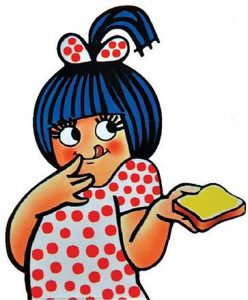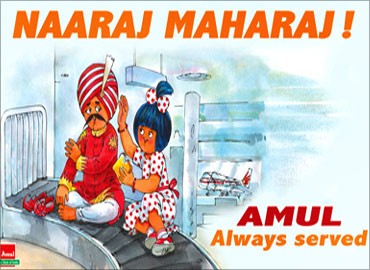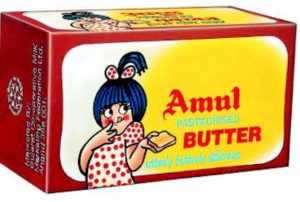Truly Amul conveys the taste of India!!
The cute little Amul girl – the mascot used by Amul has turned 50 this year. Mascots are spokes creatures, they are considered best branding elements which help consumers in brand recalling thus helping the company in their branding exercise. The mascots are often based on people, animals, or objects, mascots enable the target audience to better identify, remember, and understand a company and products. The Amul girl is a hand-drawn cartoon of a young girl dressed in fashionable attire with blue hair and a half pony tied up. Brand Amul has grown with their mascot. I think to a great extent the advertisements used by Amul have helped the brand to grow. Their ads are humorous, the Amul girl has a take on all happening in India from capturing the spirit of India in different seasons, festivals and events.
The ads have captivating slogans using parodies and satirical messages. The outdoor advertisements, the billboards are placed at busy traffic junctions which no one can miss. The mascot was born in 1966. The butter had been in the market for 10 years prior to the designing of the mascot. The mascot was designed by Eustace Fernandes and Sylvester daCunha. The Amul girl was created to give a fight to rival brand – the Polson butter. Polson butter used to have a cute little girl as their mascot. In 1966, Varghese Kurien, the head of Amul hired Advertising and Sales Promotion (ASP) prior to which their agency was FCB Ulka.
Dr. Kurien, then chairman of the Gujarat Co-operative Milk Marketing Federation Ltd. (GCMMF) suggested a mischievous little girl as a mascot with two requirements: it had to be easy to draw and memorable as most of the advertising would be outdoor media which required hand painting in those days and the hoardings had to be changed frequently. Kurien gave free hand to daCunha and Fernandes to make Amul ads. The first ad was released in March 1966 when the horse racing trend was catching up in India. It was fashionable to go to turf clubs. The rich and famous wouls go for horse racing. In the first ad, the Amul girl was seen riding a horse with the word ‘Thoroughbread’ as the punchline. The mascot, since then, has been commenting on many events of national and political importance including the 1976, emergency in India.
The Amul ad banners tell you what is current in India. What is hot? The parody in the ads have become sharper and faster with time. The Amul girl now wear skimpy clothes, her dressing also revels the fashion trends, and the liberated Indian society. The billboard of Amul in true sense conveys how India thinks, how India functions as a nation. Brand Amul has one of the longest-running advertisement campaigns in India. Amul girl is sharp witted, unapologetic, and feisty. She has a say on everything: from the weather, entertainment, sports, commodities, sports, business, politics, environment – you name the occasion, she has a viewpoint on it. She has become a perpetual part of the Indians. Her sense of humor has always been admired. The brattish mascot gets away with some nasty, tongue-in-cheek comments.
In 2001, Amul ran an ad campaign criticizing the Indian Airlines strike, at that point Indian Airlines threatened to stop offering Amul Butter on their flights unless the ads were pulled. Another ad during the Ganesh festival which said, Ganpati Bappa More Ghya (Ganpati Bappa take more). The Shiv Sena party said that if the ad wasn’t removed, they would extinguish Amul’s office. In 2011, the ad campaign came up with ‘Maine kyaa khaya’. It was themed on Commonwealth games scam against Suresh Kalmadi, the ad agency ran into trouble. Kalmadi’s party workers in Pune actually pulled down the hoarding. When the Satyam Computer Scandal took place in 2009, the Amul billboard was worded as ‘Satyam Sharam Scadalam’, there were some other spoofy posters as well. The Staym board sent threatening letters to the agency with dire consequences to be faced. Another controversy was related to Jagmohan Dalmiya, former chief of the Board of Control for Cricket in India, where the Amul ad depicted him through the three righteous monkeys who don’t hear evil, don’t speak evil and don’t see evil. The tagline was “Dalmiya mein kuchh kala hai?”
Whether it be Kim Kardashian’s denial of participation in the Indian version of Big Brother, or the stringent Union Budget, you get little bits of insight into what’s making the headlines that moment. During 1991 Amul ad showed then finance minister, Manmohan Singh, perilously walking the tightrope; it was the time India signed in to become part of the WTO.
All through the years, the charming Amul girl billboard has been kept animated by three men: helmed by Rahul DaCunha, copywriter Manish Jhaveri and illustrator Jayant Rane. Jhaveri has maintained the language quality with a unique style of vocabulary, with lots of puns and a colloquial flavor. He also brought in a new mix of regional and informal vocabulary that is loved by the public. Rane has been painting the Amul ads meticulously by hand for thirty years. All three men ensures that Amul girl’s trademark features blue hair, chubby cheeks, wide eyes, no nose and long eyelashes are not altered even while adding celebrity twists. The endowed trio have perfected the art of choosing an apt theme for the Amul girl ad which are smartly release it at the perfect moment. Most of their campaigns are specifically targeted in the regions they impact the most. While they choose the hotly trending topics from the newspapers, they get the public point of view from social media. The trio believes in keeping themselves updated with the public perception. The Amul dairy ad campaigns continue to endure public expectations with close to 6000 billboard hoardings being exhibited across India.
Though Amul girl turned fifty this year, age has not gnarled her. She looks genial and chirpier. The ‘Utterly Butterly’ Girl continues to convey the taste of India peering from the billboards. With her age, her wit and her sense of humor has been growing. She continues her satirical commenting on everything with more ferocity. In fact, people who don’t keep updated with newspapers, get the gist of what’s happening in the nation by looking at the billboard.
To celebrate the Amul Girl’s golden jubilee anniversary, DaCunha Communications has released a coffee table book Titled ‘Amul’s India’, that tells the story of an evolving India as seen from the Amul girl’s eyes. The bold and beautiful girl is truly voice of India. She has seen the good, the bad and some odds through her journey. the book captures a selection of the brand’s most popular advertisements as well as articles by different celebrities who feature in the hoardings, including megastar Amitabh Bachchan, film stars Shah Rukh Khan, Anbeer Kapoor, Deepika Padukone, cricketers Sunil Gavaskar and Rahul Dravid, commentator Harsha Bhogle, tennis star Sania Mirza, veteran filmmaker Shyam Benegal (whose daughter Pia Benegal lent her voice for the ‘Utterly Butterly’ ad jingle), news anchors Arnab Goswami and Barkha Dutt and author Shobhaa De.
She continues to be truly the most admired icon of India.


















































